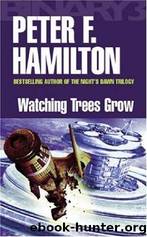Watching Trees Grow (2000) by Peter F. Hamilton

Author:Peter F. Hamilton [Hamilton, Peter F.]
Language: eng
Format: epub
ISBN: 9780575073050
Publisher: Gollancz
Published: 2009-06-11T01:00:00+00:00
CHAPTER THREE
Ganymede ID 1920
My journey out to Jupiter was an astonishing experience. I'd been in space before, of course, visiting various low Earth orbit stations which are operated by the family, and twice to our moonbase. But even by current standards, a voyage to a gas giant was considered special.
I took a scramjet-powered spaceplane from Gibraltar spaceport up to Vespasian in its six-hundred-mile orbit. There wasn't much of the original asteroid left now, just a ball of metal-rich rock barely half a mile across. Several mineral refineries were attached to it limpet-fashion, their fusion reactor cooling fins resembling black peacock tails. In another couple of years it would be completely mined out, and the refineries would be maneuvered to the new asteroids being eased into Earth orbit.
A flotilla of industrial and dormitory complexes drifted around Vespasian, each of them sprouting a dozen or more assembly platforms. Every family on Earth was busy constructing more micro-gravity industrial systems and long- range spacecraft. In addition to the twenty-seven moonbases, there were eight cities on Mars and five asteroid colonies; each venture bringing some unique benefit from the purely scientific to considerable financial and economic reward. Everyone was looking to expand their activities to some fresh part of the solar system, especially in the wake of the Caesar settlement claim.
Some of us, of course, were intent on going further still. I saw the clearest evidence of that as the Kuranda spiraled up away from Earth. We passed within eight thousand miles of what the planetbound are calling the Wanderers Cluster. Five asteroids in a fifty-thousand-mile orbit, slowly being hollowed out and fitted with habitation chambers. From Earth they appeared simply as bright stars performing a strange slow traverse of the sky. From the Kuranda (with the aid of an on-board video sensor) I could clearly see the huge construction zones on their surface where the fusion engines were being fabricated.
If all went well, they would take two hundred years to reach Proxima Centuri. Half a lifetime cooped up inside artificial caves, but millions of people had applied to venture with them. I remained undecided if that was a reflection of healthy human dynamism, or a more subtle comment on the state of our society.
Progress, if measured by the yardstick of mechanization, medicine, and electronics, seemed to be accelerating at a rate which even I found perturbing.
Too many people were being made redundant as new innovations came along, or AIs supplanted them.
In the past that never bothered us-after all who wants to spend four hundred years doing the same thing.
But back then it was a slow transition, sliding from occupation to occupation as fancy took you. Now such migrations were becoming forced, and the timescale shorter. There were times I even wondered if my own job was becoming irrelevant.
The Kuranda took three months to get me to Jupiter, powered by low-temperature ion plasma engines, producing a small but steady thrust the whole way. It was one of the first of its class, a long-duration
Download
This site does not store any files on its server. We only index and link to content provided by other sites. Please contact the content providers to delete copyright contents if any and email us, we'll remove relevant links or contents immediately.
Red by Erica Spindler(12515)
Crooked Kingdom: Book 2 (Six of Crows) by Bardugo Leigh(12255)
Twisted Palace by Erin Watt(11111)
Mindhunter: Inside the FBI's Elite Serial Crime Unit by John E. Douglas & Mark Olshaker(9257)
Fangirl by Rainbow Rowell(9169)
Never let me go by Kazuo Ishiguro(8774)
All the Light We Cannot See: A Novel by Anthony Doerr(8455)
A Man Called Ove: A Novel by Fredrik Backman(8402)
The Lover by Duras Marguerite(7854)
Confessions of an Ugly Stepsister by Gregory Maguire(7846)
Little Fires Everywhere by Celeste Ng(7147)
The Vegetarian by Han Kang(6245)
To All the Boys I've Loved Before by Jenny Han(5800)
The Shadow Of The Wind by Carlos Ruiz Zafón(5661)
On the Yard (New York Review Books Classics) by Braly Malcolm(5511)
Keepsake: True North #2 by Sarina Bowen(5401)
Dancing After Hours by Andre Dubus(5258)
Ken Follett - World without end by Ken Follett(4680)
The Perks of Being a Wallflower by Stephen Chbosky(4606)
